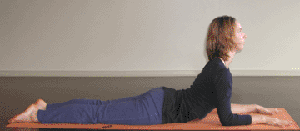
Benefits:
- Can be a very deep compression and stimulation of the sacral-lumbar arch [1]
- Tones the spine. People with bulging or herniated disks may find this very therapeutic. [2]
- If the neck is dropped back, the thyroid will also be stimulated.
- In the full Seal pose, the stomach may receive a lovely stretch, as well.
Contra-indications:
- If you have a bad back or tight sacrum
- If there are any sharp pains here, you must come out!
- Avoid pressing the belly into the floor if you’re pregnant (use bolsters under the pelvis and the forearms).
- Avoid if you have a headache.
Getting Into the Pose:
- Lie down on your belly. Clasp your elbows with the opposite hands and move the elbows just ahead of your shoulders, propping yourself up. Notice how this feels in your lower back. If the sensations are too strong, move your elbows further ahead, lowering your chest closer to the floor. If you like, you can place your palms flat on the floor in front of you like a sphinx.


- For a gentle Sphinx, rest on the ribs, sliding the elbows away to reduce compression in the lower back. Simply lying on your stomach may be enough of a backbend for you.
- You can use a cushion under the elbows, helping to elevate the chest and deepen the posture.
- Alternatively, you can place a bolster under the arm pits and relax completely.
- Seal pose with straight, locked arms is the deepest pose; let the hands rotate outward a little. Slide your hands away to lessen the intensity.
- You may feel the highest amount of compression in the lower back if your hands are not right under the shoulders but slightly forward. This provides some pressure in the lower back.
- Rather than have the arms in front, Paulie Zink likes to have the hands and arms straight out to the side, which makes this look more like a seal.
- Bend the knees for more compression in the sacrum.
- You may spread the legs apart to deepen the sensations in the lower back.
- You may prefer to keep the legs together to release the sacrum or make the sensations more even along the spine.
- You can place a bolster or blanket under the pubic bone or thighs to soften the pressure. This is really nice for pregnant women.
- Tightening the buttocks is okay within reason. Sagging the shoulders is also okay.
- To arch the neck and stimulate the cervical spine, lengthen the neck, drop the head back, lift the chin, and open the throat.
- If your head gets too heavy for your neck, try resting your head in your hands or your chin on your fists.
- If you’re flexible, try these postures with the legs in lotus.
Coming Out of the Pose:
- To come out, slowly lower your chest to the floor. Turn your head to one side and rest your cheek on your palms. You may wish to decompress the lower back more by sliding one knee up. Choose the knee that you are looking toward, and keep the knee and foot on the floor.
Counter poses:
- Child’s Pose is a nice, gentle forward fold; move into it slowly. You may need to rest your head on your palms.
- On your way to Child’s Pose you may crave Cat’s Breath: flow from the Upward Facing Cat to the Downward Facing Cat (aka Cat/Cow) but flow gently, in time with the breath. Don’t make these your deepest Cats ever.
Meridians & Organs Affected:
- Affects the Urinary Bladder and Kidney lines as they run through the lower back and sacrum
- Affects the Stomach and Spleen meridians along top of legs
- Stimulates the kidneys and adrenal glands through compression [3]
Joints Affected:
- Lower spine and the neck (if dropped back).
Recommended Hold Times:
- Sphinx can be held longer than Seal
- For Seal, start with one minute holds, then lower down, rest, and repeat several times
- Up to five minutes
- Eventually up for twenty minutes!
Similar Yang Asanas:
- Sphinx and/or Cobra.
Other Notes:
- Imagine the spine like a row of Christmas tree lights draping to the floor;
- If the arms are straight, this pose is a deeper backbend than Saddle and, thus, could be done after Saddle. If the arms are bent (as in Sphinx), this is not as deep as Saddle, so it may be done beforehand.
- Seal is nice and safe if you’re pregnant.
- Ideal for adding some breath work and conscious energy movement
- Great pose for watching television!
The above video is an extract from Using Props in Yin Yoga,
which is a 50-minute video.
- — Between the L2 and L3 vertebrae is found the “Door of Life,” where Jing energy is housed.
- — In the physiotherapy world, this is known as McKenzie therapy. For people with flexion-caused problems in the lower back (such as a slipped disk), backbends can ease the nucleus pulposus back into the middle of the disk.
- — Iyengar, Light on Yoga.

